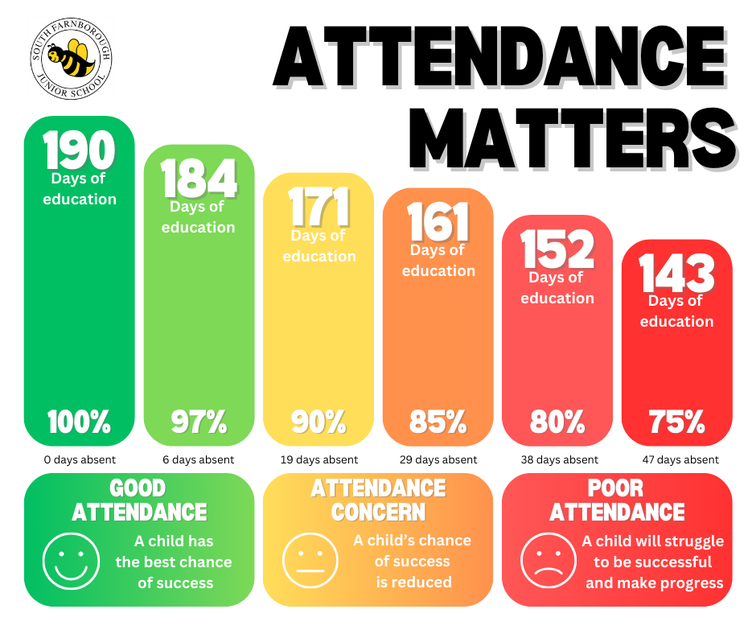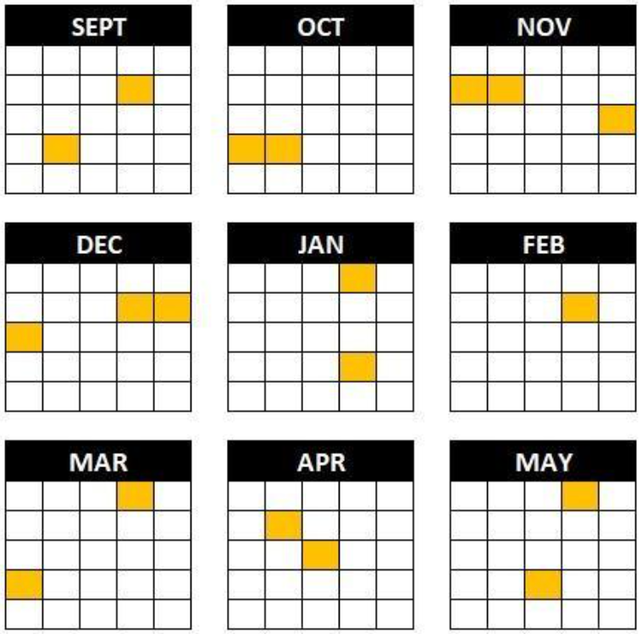Attendance

As a school we actively promote excellent attendance and will look to support and challenge weaker attendance, this includes punctuality. We encourage each child to achieve excellent attendance with a wide range of incentive awards outlined further down this page. Excellent attendance is the essential foundation to positive outcomes for all pupils including their safeguarding and welfare.
Please do look through the information on this page so you understand what we expect and how we can support you.
Our Senior Attendance Champion is Mrs Plummer and her role is to set a clear vision for improving and maintaining good attendance, as well as establishing effective systems for tackling absence.
The Department for Education state that;
"The law entitles every child of compulsory school age to an efficient, full-time education suitable to their age, aptitude, and any special educational need they may have. It is the legal responsibility of every parent to make sure their child receives that education either by attendance at a school or by education otherwise than at a school.
Where parents decide to have their child registered at school, they have an additional legal duty to ensure their child attends that school regularly. This means their child must attend every day that the school is open, except in a small number of allowable circumstances such as being too ill to attend or being given permission for an absence in advance from the school."
"The most effective schools consistently promote the benefits of good attendance at school and make schools a place pupils want to be, set high expectations for every pupil, communicate those expectations clearly and consistently to pupils and parents, systematically analyse their data to identify patterns to target their improvement efforts, and work effectively with the local authority and other local partners to overcome barriers to attendance. They also recognise that attendance cannot be seen in isolation and that the foundation to good attendance is a calm, orderly, safe and supportive environment in which all pupils can learn and thrive. To manage and improve attendance effectively, all schools are expected to:
- Build strong relationships and work jointly with families, listening to and understanding barriers to attendance and working in partnership with families to remove them.
- Develop and maintain a whole school culture that promotes the benefits of high attendance.
- Have a clear school attendance policy which all staff, pupils and parents understand.
- Accurately complete admission and, with the exception of schools where all pupils are boarders, attendance registers and have effective day to day processes in place to follow-up absence.
- Regularly monitor and analyse attendance and absence data to identify pupils or cohorts that require support with their attendance and put effective strategies in place.
- Share information and work collaboratively with other schools in the area, local authorities, and other partners where a pupil’s absence is at risk of becoming persistent or severe.
- Be particularly mindful of pupils absent from school due to mental or physical ill health or their special educational needs and/or disabilities, and provide them with additional support.
The link between absence and attainment at KS2
Policies and Guidance to Support Your Child's Attendance
- Copies of our latest attendance and behaviour policies can be found here
- Hampshire's guidance for behaviour and attendance, please click here
- Securing good attendance and tackling persistent absence, please click here
- Working together to improve school attendance, please click here
- DfE - The Education Hub, please click here
- How to improve your child's school attendance and where to get support, please click here
- Mental health resources for children, students, parents, carers and school/college staff, please click here
Persistent Absence
What percentage is classed as persistent absence?
Persistent absence is when a pupil enrolment's overall absence equates to 10 per cent or more of their possible 190 sessions.
The following table shows how many days off will make your child a persistent absence student.
A typical pattern of absence could look like the following example.
19 days absence = 90% attendance

Attendance Awards
We have weekly, termly and annual awards to encourage the children to recognise the importance that we place on good attendance and for them attend school regularly and on time.
Weekly
Every pupil gaining *100% for a week has their name entered into a prize draw and earn a buzz point for their house. One name is drawn for each class at the end of the week and that child will be awarded with an attendance prize. Every pupil is also entered into a termly prize draw for a golden ticket to the yearly reward day celebration.
Termly
Every pupil gaining over 98% attendance for a term is awarded with a badge as follows

- Bronze for one full term
- Silver for two full terms
- Gold for three full terms
Yearly
Every child attaining 100%* for the year is invited to attend a reward day celebration for their attendance achievement.
There will also be places available for the most improved attendance over the year and for the children with the golden tickets from the weekly draws.
* We do recognise that some children may have to leave school slightly early, arrive late to school, or leave and return within the school day to attend an unavoidable medical appointment; such as consultant hospital appointments, orthodontist appointments and emergency doctor/dentist appointments. Due to this, these children will be identified, case by case, and may still receive their award.
